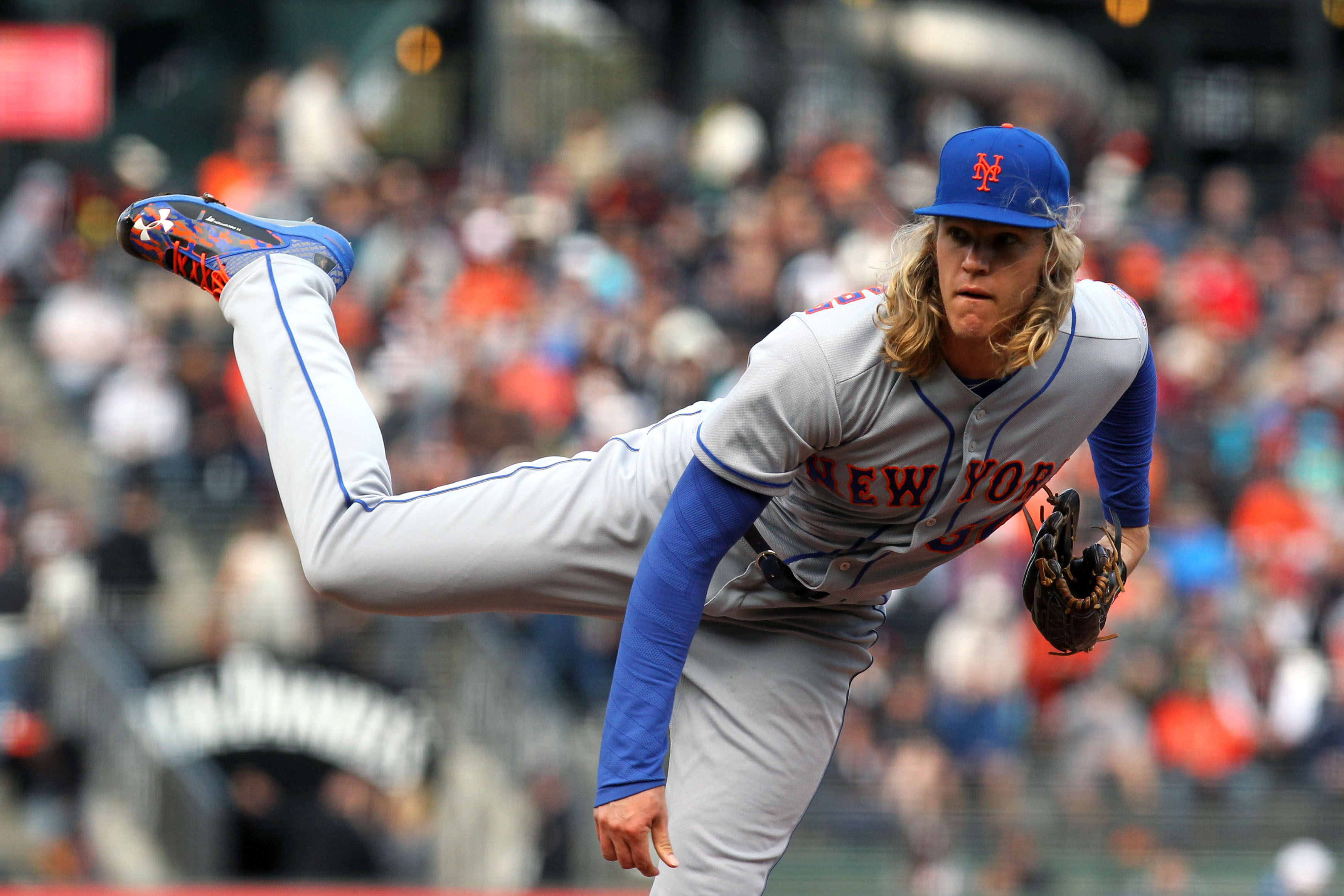When Noah Syndergaard broke into the majors early last season, it was a seismic event for the Mets. With him in the shorthanded rotation, given the loss of Zack Wheeler in spring training to Tommy John surgery, the Mets played well enough in the first half to stay competitive and then steamrolled through to the NL East title and, eventually, their first World Series appearance in 15 years.
And I remember the moment that it started to feel inevitable, like maybe 2015 was the season when everything finally wouldn’t all go to hell. It was August 2, a Sunday night game on ESPN, and Syndergaard was sensational in eight innings of work. His fastball looked unhittable all night, especially with Bryce Harper flailing at his final offering to end the eighth. That win wrapped up a sweep of Washington, tied up the division, and the Mets took a one-game lead over the Nats the next day that they never relinquished.
The circumstances were quite different this past Sunday night, when Syndergaard put in another sterling effort, but his performance gave off that whiff of what every Mets fan felt at Citi Field a year ago. With eight seemingly effortless innings of dominance over a struggling San Francisco squad, Syndergaard showed that, even when compromised with that nagging bone spur in his elbow, he can still perform like one of the best pitchers in the National League.
I wrote last week about how Steven Matz should simply be shut down for the remainder of the year because the Mets are no longer realistically playing for anything beyond the original 162, and I feel the same about Syndergaard. Even more so than Matz, Syndergaard is the cornerstone for the future and the team would be foolish to play games with his long-term health. Going into Monday night, the Mets are a .500 club that is actually outplaying its Pythag by a game and remains the third team on the outside looking in on the NL Wild Card hunt. This isn’t the year for this team and they simply don’t need to see any more from Syndergaard to know what they have, and what they have is a dominant No. 1 ace-type pitcher, so long as they don’t screw him up.
But at this point, it’s a fine time to see just how much better Syndergaard has pitched this year as opposed to his rookie campaign. He pitched 150 innings and faced 603 batters last season; he’s up to 148 and 602 respectively in 2016. He made 24 regular season starts both last season and now this. So the time is perfect to see what’s happening with Syndergaard’s results both then and now.
2015: 2.98 DRA, 79 cFIP, 10.0 K/9, .279 BABIP, 166 K, 5.35 K/BB
2016: 2.71 DRA, 68 cFIP, 10.8 K/9, .343 BABIP, 177 K, 5.53 K/BB
The inflated BABIP is a direct result of Syndergaard cutting his dingers allowed down from 19 to 9. (Those balls have now become doubles, which increased from 17 to 30.) But his historically good K/BB ratio from his rookie season has only improved, as his strikeouts have gone up even as his command has stayed roughly the same. (You could even presume that his walks might even be a touch lower without the bone spur.) His groundball rate is up; the flyball rate is down. Almost everywhere you look, there’s improvement in Syndergaard’s peripherals—he should be a top-five vote-getter for NL Cy Young, and I couldn’t care less how many steals he allows—and he has firmly established himself as the undisputed ace of Dan Warthen’s stable of starters.
Which is exactly why the Mets need to be extraordinarily careful with Syndergaard. He’s still below last year’s mark for innings pitched, but the bone spur means he’s compromised. With a little luck, the Mets can likely enter next Opening Day with a rotation featuring Syndergaard, Jacob deGrom, Matz, Matt Harvey, and Wheeler. That’s a rotation that doesn’t keep you up at night, and with those five rested and recovered the Mets could be the favorites in the division once again. But that means making smart decisions now. When Terry Collins pulled Syndergaard on Sunday night with 98 pitches thrown, it felt like the most logical move he’s made in weeks. But the Mets need to take that logic and expand it to a higher degree, and if that means effectively punting on the season with still six weeks remaining, so be it.
It’s too easy to think that it’s fine to let Syndergaard ride this season out to its inevitable endpoint, that his recovery of lost velocity from earlier in the season means he’s good to go until the season’s last day. That’s what pitchers tell managers to let them stay in ballgames, but managers need to manage better than that. But this ultimately needs to come from Sandy Alderson, and it needs to come quick. Winning in 2017, in many ways, means treating that season like it’s already here.
Photo Credit: Lance Iversen-USA TODAY Sports

1 comment on “Sit Syndergaard or Let It Ride?”
Comments are closed.